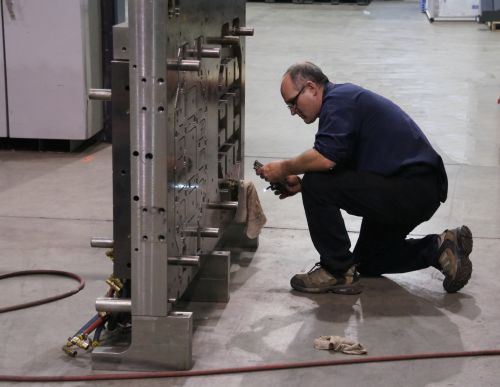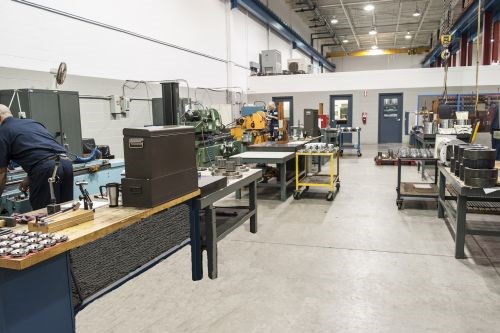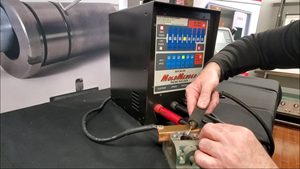A Dedicated Approach to Maintenance and Repair
Isolating these operations from the rest of the shop provides a competitive edge for this large plastic injection mold manufacturer.
“It’s a completely different mindset.” That’s how Jordan Robertson responds to a question about what’s involved with maintaining, repairing or refurbishing a mold versus making one, and he would know. Robertson is general manager, business development and marketing for StackTeck, one of North America’s largest plastic injection mold manufacturers and the operator of a particularly robust repair and maintenance service in Brampton, Ontario. He’s also been at the company long enough to remember a time when priorities between making molds and keeping them running often conflicted. “A build program that might have a lead time of 10 weeks or more requires a different type of focus from managing a repair with a three-week lead time,” he explains. “In order to truly thrive, we had to literally put up walls to isolate the repair and maintenance team in their own dedicated area, separate from the rest of the business.”
A Dedicated Team
Those 13 team members are among the most 220-employee company’s most skilled toolmakers. Unlike the specialists in the broader shop, repair and maintenance requires mastery of a variety of different types of machinery, not to mention the engineering skill to solve problems within existing designs rather than creating new ones. Additionally, giving closure, packaging, medical and multi-level stack tools the proper love and care requires a trained eye and a seasoned hand at the bench. Doing it properly also requires time, and StackTeck has found that having a dedicated, isolated department reduces the pressure to compromise due diligence in favor of pushing through other urgent work, Robertson says.
That goes for more than just those in the proverbial trenches. “It’s not at all unusual for a project manager to have a full-day meeting with a customer about mold design,” he explains. “If an urgent repair job comes in that same morning and needs that same person’s attention, you’ve just lost a whole day on a priority delivery.”
A Supporting Cast
The rationale is the same for dedicating equipment, Robertson says. The 8,000-square-foot department, which typically handles 6-8 repair or refurbishment jobs per month, is in many ways a microcosm of the broader shop. Machining, grinding, inspection, polishing—all have a place here.
Still, Robertson emphasizes that the walls around this area are meant only to keep sensitive operations out of sight of visitors. Strategic access to the rest of the 130,000-square-foot facility—particularly plastic-part inspection resources and a bank of molding presses—provides an edge over smaller repair and maintenance operations located closer to customers. The company has seven machines available for testing: two Netstals, three Huskies and two Demags (one of these, a 450T El-Exis, is a recent addition that replaced an older machine). Altogether, these systems provide the ability to fully qualify any work within the 100 to 600-ton range.
Efficient, Comprehensive Service
While the resources above provide a more comprehensive offering, the efficiency advantages of a dedicated approach enable StackTeck to compete on delivery no matter where the customer is located, Robertson says. Although lead times vary according to job requirements, they’re typically less than a month for repairs, he notes, adding that this figure includes the time required to ship a mold from Ontario to virtually anywhere in North America.
It takes a company of a certain size to truly emulate StackTeck’s approach. Nonetheless, the company’s experience demonstrates that to whatever extent possible, strategically isolating functions with differing priorities from the rest of the business can lay the groundwork for a more efficient and more comprehensive service. In this particular case, those advantages have been enough to attract more than enough repair and maintenance work to keep the department busy during the 15 years since the transition, Robertson says. “Probably the biggest change we’ve seen since we set it up was a major increase in this type of work, and it’s remained steady,” he says. “It was a bit of a leap of faith—‘build it, and they will come’—but it’s worked out for us.”
Related Content
Portable Low-Heat, Non-Arcing Resistance Welder for Mold Repair
Rocklin’s user-friendly MoldMender Micro Welder delivers simple and cost-effective localized repair in-house with precision and versatility, enhancing mold and die durability and reducing disassembly and downtime.
Read MoreHow to Use Scientific Maintenance for More Accurate Mold and Part Troubleshooting
Discover how adopting scientific maintenance approaches helps improve mold lifespan, minimize failures, and optimize production outcomes.
Read More5 Hot Runner Tips for Moldmakers and Molders
Best practices for initial hot runner tryouts and effective preventive maintenance.
Read MorePrecision Meets Innovation at IMTS 2024
After attending IMTS, it's clear that the integration of advanced technologies is ready to enhance precision, efficiency and automation in mold manufacturing processes. It’s a massive event, so here’s a glimpse of what the MMT team experienced firsthand.
Read MoreRead Next
How to Use Continuing Education to Remain Competitive in Moldmaking
Continued training helps moldmakers make tooling decisions and properly use the latest cutting tool to efficiently machine high-quality molds.
Read MoreReasons to Use Fiber Lasers for Mold Cleaning
Fiber lasers offer a simplicity, speed, control and portability, minimizing mold cleaning risks.
Read MoreAre You a Moldmaker Considering 3D Printing? Consider the 3D Printing Workshop at NPE2024
Presentations will cover 3D printing for mold tooling, material innovation, product development, bridge production and full-scale, high-volume additive manufacturing.
Read More























